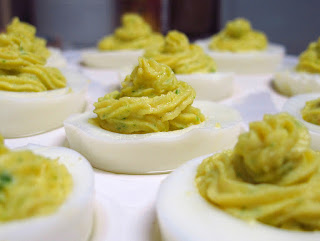 Deviled Eggs
Deviled Eggs
Also
known as stuffed eggs, starts with hard-boiled eggs,
peeled, cut in half and stuffed with a seasoned, mashed yolk mixture.
The yolks
are removed from the whites, mixed with a moistener, such as
mayonnaise,
flavoring foods and/or seasonings and then piled back into the whites.The word “devil” originally referred to the combination of spices, including dry mustard and vinegar with which the eggs were highly seasoned.
Deviled Eggs are easy to make and allows creativity to flow in regards to the variety of combinations one can come up with. Check out the recipes below or create your own:
<Sriracha Deviled Eggs
Lobster Deviled Eggs
Bacon and Cheddar Deviled Eggs Recipe
Smoked Salmon Deviled Eggs
Wasabi Deviled Eggs
Seafood Deviled Eggs >
What is your favorite Deviled Egg Recipe?
FYI!
Hard-boiled eggs will easily
reach internal temperatures of more than 160°F (71°C) when they are
done. Note, though, that while Salmonella are destroyed when
hard-boiled eggs are properly prepared, hard-boiled eggs can spoil more
quickly than raw eggs.
To make Hard boiled eggs, place eggs in a saucepan large enough to hold them in a single layer. Add enough cold water to come at least 1 inch above the eggs. Heat over high heat to boiling. Turn off heat. If necessary, remove the pan from the burner to prevent further boiling. Cover pan. Let the eggs stand in the hot water about 12 minutes for large eggs (about 9 minutes for medium, about 15 for extra-large).
After cooking, cool the hard-boiled eggs quickly under running cold water or in ice water. Avoid allowing eggs to stand in stagnant water. Refrigerate hard-boiled eggs in their shells promptly after cooling and use them with one week.
To peel an egg, crackle the shell all over by gently tapping the egg on a table or countertop. Roll the egg between your hands to loosen the shell. Then peel off the shell, starting at the large end. Hold the egg under running water or dip it in water to make peeling easier.
A nicely centered yolk makes very attractive deviled eggs and garnishes. However, as an egg ages, the white thins out which gives the yolk more opportunity to move about freely. This can result in a displaced yolk when you cook the egg. Using the freshest eggs possible will minimize this displacement, but very fresh eggs are more difficult to peel after hard boiling.
The best compromise for attractive eggs with centered yolks that are relatively easy to peel seems to be using eggs that have been refrigerated for about a week to 10 days. Some new research suggests that yolk centering may be better if you store eggs small-end up for 24 hours before hard-boiling.
Resource:
Incredibleegg.org
America Egg Board




No comments:
Post a Comment